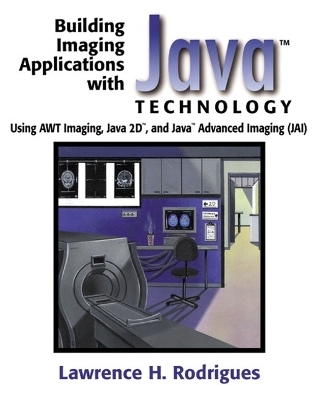
Building Imaging Applications with Java™ Technology
Addison Wesley (Verlag)
978-0-201-70074-9 (ISBN)
- Titel ist leider vergriffen;
keine Neuauflage - Artikel merken
This is an expert guide to building sophisticated Java graphics and imaging applications with the Java 2 platform. Through extensive practical examples and projects, leading graphics developer Lawrence Rodrigues covers topics that other Java graphics books ignore -- including the first in-depth coverage of using the new Java Advanced Imaging (JAI) APIs, and integrating them with Java2D. Rodrigues covers all aspects of building Java-based graphics and imaging software, starting with application design. He demonstrates how to generate graphics, load and display them, manipulate, print, and save them. He also covers several advanced topics, notably remote imaging. The book presents detailed coverage of four key Java graphics class libraries, including java.awt.Graphics, java.awt.Graphics2D, java.awt.color, and java.awt.font. Each chapter ends with a project that helps readers integrate every key concept they've learned. For every intermediate-to-advanced level Java developer interested in building sophisticated graphics and imaging applications.
Lawrence H. Rodrigues is a lead applications architect who was an early adopter of the Java programming language. During more than 20 years in industry, he has designed and developed several real-world applications in the fields of medical imaging, satellite imaging, and Internet imaging, including state-of-the-art imaging software for CT and MR scanners for a leading medical imaging company. Larry writes and lectures extensively and is also the author of The Awesome Power of JavaBeans™ (Manning, 1998). 0201700743AB05072001
Preface.
1. Introduction.
Getting started with Java.
Type of Java Programs.
Approaches to Building an Application with Java.
Imaging.
Evolution of Java Imaging APIs.
How to Use This Book?
Conclusion.
I. AWT IMAGING.
2. AWT Image Loading.
Image Loading Approaches.
Asynchronous Image Loading in the AWT.
Image Loading Stages.
Image Loading Using the MediaTracker Class.
Loading Multiple Images.
Image Loading Problems.
Representing an Image.
Using the ImageLoader Class.
Loading Images from Jar Files.
Putting it all Together: MultiImageLoader Bean.
Conclusion.
3. Rendering Images in the AWT.
Describing an Image.
Overview of the AWT Imaging API.
Displaying an Image.
Using Image Filters.
Printing.
Putting it All Together: An Image Viewer Applet and Application.
Conclusion.
II. JAVA 2D.
4. Basics of Java 2D Graphics.
Application Coordinate Systems.
Device Coordinate Systems.
Describing a Shape.
Shapes.
Curves.
Introduction to Affine Transformation.
Conclusion.
5. Rendering Graphics in Java 2D.
Rendering Graphics Objects.
Using the Graphics Class.
Painting in AWT Components.
Painting in Swing Components.
Enter Java 2D.
Graphics2D Rendering Operations.
Interactive Graphics.
Building Interactive Drawing Applications.
Designing a Library of Shapes for Interactive Drawing.
Shapes Library Implementation.
Writing a Shapes Library Client.
Putting it All Together: The JavaPaintShop Application.
Conclusion.
6. Rendering Images in Java 2D.
Immediate Mode Model.
Bridging the Immediate Mode Model with the Push Model.
JPEG Viewer: A Simple Image Rendering Example.
Image Browser: An Example to Aggregate Images.
Designing a Component Class for Displaying Images.
Printing in Java 2.
Image Printing Requirements.
Putting it All Together: A Java 2D Image Viewer.
Conclusion.
7. Manipulating Images in Java 2D.
What is Interpolation?
Applying Affine Transformation to Images.
Image Manipulation Requirements.
Implementing a Canvas for Image Manipulation.
Pan.
Zoom.
Implementing Pan and Zoom Together.
Implementing a Lens.
Other Zooming Techniques.
Rotate, Shear and Flip.
Conclusion.
8. Manipulating Image Data.
Another Look at the BufferedImage Class.
Color Management.
Overview of the Color API in Java 2D.
Managing Image Data Storage.
Constructing a BufferedImage from Data.
Working with the Raster, SampleModel and DataBuffer Classes.
Calculating Image Statistics.
Obtaining Image Information.
Histogram.
Putting it All Together: An Image Data Viewer.
Image Data Manipulation Using Filters.
Adjusting Window/Level: An Example Using the LookTableOp.
Conclusion.
9. Building an ROI Application.
A Scenario.
Steps to Building an ROI Application.
Marking ROI Shapes.
Graphics Overlay.
ROI Measurements.
Designing APIs for ROI Analysis.
Building a Quantitative Analysis Application.
Conclusion.
III. JAVA ADVANCED IMAGIN (JAI).
10. Introduction to JAI.
JAI Architecture.
Pull Model API.
Overview of JAI.
Using the JAI class.
Getting Started.
A Simple Example to Load and Display an Image.
Putting it All Together: A PlanarImage Viewer.
Conclusion.
11. Rendering Images in JAI.
Rendering Hints.
Managing Memory.
Scheduling Tiles.
Reformatting an Image.
Extending the Border.
A Rendering Example.
Closer Look at the PlanarImage Class.
Using the RenderedOp Class.
Working with Tiles.
Tiled Image Viewer.
Writing to Pixels.
Creating an Aggregate Image.
Renderable Layer.
Conclusion.
12. Manipulating Images in JAI.
Interpolation in JAI.
Using the Affine Transform Operators.
Interactive Manipulation.
Cropping an Image.
Projections.
Warping.
Conclusion.
13. Manipulating Images in JAI.
Types of Operations.
Running Operators.
Spatial Operations.
Edge Detection.
Dithering.
Implementing a Lookup Table.
Adjusting Window/Level.
Point Operators.
Color Conversion.
Frequency Operators.
Conclusion.
14. JAI: Analyzing Images in JAI.
Computing Statistics.
Region of Interest Computation.
Putting It All Together: An ROI Analyzer Application.
Conclusion.
IV. NETWORK IMAGING.
15. Remote Imaging.
Client-server Architecture.
Distributed Computing.
What is RMI?
Remote Imaging Using RMI (Remote Method Invocation).
A Simple Client-Server example.
Remote Imaging with JAI.
Conclusion.
16. Internet Imaging.
A Scenario.
Understanding the World Wide Web.
What is a Servlet?
Getting Started with Servlets and JSP pages.
Using JAI with Servlets.
JavaServer Pages.
Architecting Web-based Imaging Applications.
Applets and Servlets.
Putting it all Together.
Internet Imaging Protocol (IIP).
Conclusion.
V. MISCELLANEOUS.
17. Image I/O.
Using the JPEG Codec.
Overview of the JAI Codec Package.
Using the Image I/O API.
Conclusion.
18. Summary and Conclusions.
Comparing AWT Imaging, Java 2D and JAI.
Visualization Framework.
VI. APPENDIXES.
Appendix A: Some Utility Classes.
Appendix B: JavaBeans.
Appendix C: A Bean Collection.
Bibliography.
Index.
| Erscheint lt. Verlag | 18.6.2001 |
|---|---|
| Verlagsort | Boston |
| Sprache | englisch |
| Gewicht | 1299 g |
| Themenwelt | Informatik ► Programmiersprachen / -werkzeuge ► Java |
| Mathematik / Informatik ► Informatik ► Web / Internet | |
| ISBN-10 | 0-201-70074-3 / 0201700743 |
| ISBN-13 | 978-0-201-70074-9 / 9780201700749 |
| Zustand | Neuware |
| Haben Sie eine Frage zum Produkt? |
aus dem Bereich


